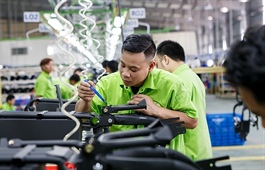How Vietnam can invest in food competitiveness by ramping up bulk import infrastructure
How Vietnam can invest in food competitiveness by ramping up bulk import infrastructure
Vietnam is the third largest importer of maize, and the 22nd largest importer of wheat (2019, FaoStats). Maize is mostly commonly used in animal feed production whereas wheat is typically routed towards flour mills and human consumption. As wheat and corn do not thrive under tropical conditions, most of the wheat and maize are shipped into Vietnam. Bulk vessels transport the raw materials needed to satisfy our cravings for noodles, breads, chicken, pork or beef.
Grain imports are the backbone of Vietnam food supply chains
Wheat imports into Vietnam have roughly doubled in the last decade, without signs of slowing down. Rising median income has led to an urban middle-class that is slowly moving away from rice diets given their preference for more varied and westernised diets. This trend, common in most Southeast Asian countries, is boosted by Vietnam’s burgeoning demography that is growing steadily towards 100 million inhabitants.
Diets in Vietnam also rely heavily on animal protein and meat, in the following order of popularity: pork (30kg/year/inhabitant), chicken (14kg) and beef (10kg). While Vietnam’s meat consumption remains relatively low compared to other parts of the world such as Singapore, Australia or the EU, the growing popularity of meat necessitates large quantities of animal feed raw materials to be imported into Vietnam. Animal feed imports have risen sixfold between 2009 and 2019.
Consequently, bulk imports of both wheat, maize and soybean meal (also used in animal feed) are of strategic importance for downstream food supply chains: a matter of food security and competitiveness as the price of raw materials has downstream consequences weighting on product prices for domestic consumption and exports. A way to guarantee competitiveness is to continue to invest in our maritime bulk import capabilities by looking at best practices in Asia and beyond.
|
|
Vietnam must continue to build its grain importing infrastructure
A first factor to take into consideration when discussing import capabilities is the availability of commercial deep seaports. Vietnam’s eastern seafront stretches over 3,000km, offering plenty of strategic locations for such infrastructures. Around 15 ports have the capability to receive large bulk vessels, with two strategic “hubs” organized around Cai Lan in the North, and Cai Mep and Phu My in the South. However, the capacities of these ports vary greatly, due to the quantity of berths and quality of their infrastructure.
Building new berths is not necessarily a necessity to increase port capacity. In most cases, modernizing the unloading equipment is sufficient to increase port capacities. Most unloading facilities in Vietnam either empty vessels with excavators or “grab” unloaders. These systems are slow, generate dust and require manpower to operate. By contrast, mechanical ship unloaders are vastly superior. Regionally, these systems can already be found in Japan, China, the Philippines and soon, in Indonesia. Mechanical ship unloaders ensure gentle handling (reducing kernel damage and subsequent quality issues) while allowing for large capacity transfers, which increase the rate of ship turnaround and overall port capacity.
One of the most recent mechanical ship unloaders installation in Southeast Asia is in Indonesia, the largest wheat importer globally, vastly dependent vessels for wheat and corn imports. KBS, the operator of Krakatau International Port (Cigading Port), the largest dry bulk port in Indonesia successfully installed the ship unloader with discharge rate up to 1,300 tonnes per hour/20,000 tonnes per day in mid-2020. This is of strategic importance when considering that the larger the vessel, the lower will be the cost of grain per tonne. Therefore, by enabling a greater number of large vessels (PANAMAX and above) to dock in Indonesia, the entire food industry gains in price efficiency, enabling affordable food to reach millions of people. Storage capacity may also lead to further gains in competitiveness
Modernizing our country’s grain operations does not stop there. Once the grain is unloaded, it must be gently conveyed into storages. Grain conveying is key to preserve product integrity. Enclosed belt conveyors can protect grain from the elements and prevent foreign material from degrading product quality. It can also shelter the neighbouring populations from the air pollution that may arise from grain dust emissions.
Grain then reaches silos for temporary storage. The quality of storage will greatly impact the competitiveness of a business. Let’s consider the size first. The size of storage allows larger and more frequent vessels to unload grain. This can present a competitive advantage when the price of grain fluctuates: larger storage capacity allows to buy grain at a lower price.
The other factor to consider is the quality of grain within the storage. In our tropical climates, silos need to be vented to reduce internal temperature and prevent grain from degrading. Here, cooling systems, still uncommon in Vietnam, offer a promising solution. By keeping overall temperature and moisture at lower levels, grain qualities are preserved for longer periods of time. Such devices, combined with IOT sensors, allow for close monitoring of grain quality to avoid unnecessary losses and ensure food safety for downstream applications by preventing parasites or mold growth.
In conclusion, there are many ways in which Vietnam can continue to develop its bulk infrastructure capabilities to increase efficiency at existing or future deep-sea ports. Increments in competitiveness enabled by better unloading, conveying, and storing technologies go a long way and add up to provide significant gains to downstream activities. Breads, noodles, biscuits, as well as pork or chicken meat all benefit from better prices in grain import. By positioning Vietnam as a best-in-class grain importer, we are not only investing in our country’s food security, but also supporting our economy as Vietnam can consequently strengthen its position as one of the Association of Southeast Asian Nations’ (ASEAN) most prominent food exporter.



























